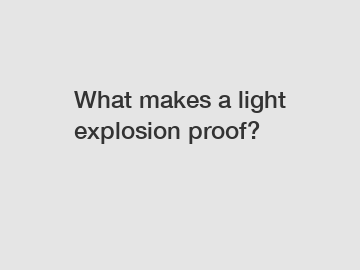What makes a light explosion proof?
What makes a light explosion proof?
Explosion-proof lighting is a critical safety component in various industries where volatile gases, dust, or flammable materials are present. These specialized lighting fixtures are designed to prevent ignition sources and minimize the risk of explosions. How do these lights achieve this level of protection? Let's explore the key factors that make a light explosion proof.
1. Enclosures that withstand explosions:

Explosion-proof lights are constructed with robust enclosures made from durable materials such as aluminum or stainless steel. These enclosures are designed to contain any potential explosion within them, preventing it from escaping and creating a hazardous environment. The enclosures also protect the internal components of the light from external impacts, ensuring their integrity.
2. NEMA ratings for hazardous locations:
National Electrical Manufacturers Association (NEMA) ratings play a crucial role in classifying explosion-proof equipment. These ratings provide an industry-standard system for defining the level of protection against hazardous environments. For explosion-proof lights, a high NEMA rating such as NEMA 7 or NEMA 9 is commonly required, indicating their suitability for use in areas with flammable gases, dust, or combustible fibers.
3. Specialized wiring and sealing methods:
To maintain the explosion-proof nature of the light, special wiring techniques and sealing methods are employed. These ensure that no sparks or hot surfaces are exposed to the surrounding atmosphere. The wiring is often encapsulated in explosion-proof conduit, providing an additional layer of protection. Proper sealing of the light's entry points, such as cable glands or threaded entries, prevents any flammable substances from seeping into the light fixture.
4. Protective features to prevent ignition:
Explosion-proof lights are equipped with various features to prevent the risk of ignition. One common feature is the use of explosion-proof glass or polycarbonate lenses, which are impact-resistant and designed to contain any potential sparks or hot fragments. Additionally, these lights may incorporate thermal protection devices that automatically shut off the light if it reaches certain temperature thresholds, preventing any excessive heat buildup.
5. Compliance with safety standards:
To be considered explosion proof, lights must undergo rigorous testing and comply with safety standards set by organizations such as Underwriters Laboratories (UL) and the International Electrotechnical Commission (IEC). These standards ensure that the lights meet specific criteria for withstanding explosions and minimizing ignition risks. Compliance with these standards provides assurance to industries relying on explosion-proof lighting that the products they use are reliable and safe.
In conclusion, explosion-proof lights are designed with multiple key factors in mind to ensure the highest level of safety in hazardous environments. The robust enclosures, high NEMA ratings, specialized wiring, and sealing methods work together to contain any potential explosions and prevent ignition sources from causing catastrophic incidents. By complying with safety standards, explosion-proof lights provide peace of mind to industries that rely on them. Knowing what makes a light explosion proof enables us to appreciate their role in safeguarding lives and property in challenging industrial settings.
If you want to learn more, please visit our website Explosion-proof Spotlight Fittings, waterproof fluorescent light fixtures, explosion proof cable glands.
162
0
0


Comments
All Comments (0)